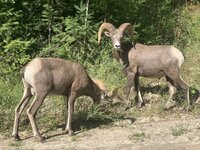I've lived around a small herd of bighorn sheep my entire life. People have always spoken of them as a rare and unique sight to see. They'd be in one part of the canyon, but not another equally as cliffy part a few miles away. In my lifetime, their population hasn't appeared to have grown or expanded in that area.
Internet searches put elk populations currently at around 1 million in NA. In the early 1900's, populations were around 40,000.
Around the turn of the 19th century, the internet tells me there were an estimated 1.5-2 million bighorns. Currently estimates are at around 70,000. With the prevalence of observable elk nearby, it doesn't seem like a huge stretch to imagine there would likely have been bighorns on pretty much every cliffy area around, at every elevation, and in higher numbers than elk.
How have elk populations apparently flourished through conservation, while bighorn populations have appeared to remain stagnant or even shrink? The North American Model of wildlife conservation has appeared to have worked wonders for elk. Is it alone not working for bighorns? Something isn't adding up to me.
I'm embarrassed to say I've been ignorant of anything to do with bighorn sheep conservation for most of my life. Only in the past few months have I been tying to Google some of these answers. I'm sure many of you are very familiar with this issue, so I'm curious to hear what you know.
I came across this film that suggests that domestic sheep may be a culprit in that they transmit something called M. Ovi to bighorns:
. The sense I get from it is something akin to Europeans coming to America and giving natives smallpox. The fact that comments have been turned off on this video tells me this is a contentious issue, but I wish to learn more from both sides to understand why we are where we are.
Thinking back to the canyon where I've known bighorn sheep to live, there are indeed domestic sheep at the end of the canyon where the bighorns don't seem to go. I'm sure this is a simplified view, but are those domestic sheep really the reason why bighorns aren't expanding into more of their historical habitat? And if domestic sheep interactions are the primary culprit to bighorn dieoffs, there must be some individuals and groups working very hard to keep bighorns from extinction.
Internet searches put elk populations currently at around 1 million in NA. In the early 1900's, populations were around 40,000.
Around the turn of the 19th century, the internet tells me there were an estimated 1.5-2 million bighorns. Currently estimates are at around 70,000. With the prevalence of observable elk nearby, it doesn't seem like a huge stretch to imagine there would likely have been bighorns on pretty much every cliffy area around, at every elevation, and in higher numbers than elk.
How have elk populations apparently flourished through conservation, while bighorn populations have appeared to remain stagnant or even shrink? The North American Model of wildlife conservation has appeared to have worked wonders for elk. Is it alone not working for bighorns? Something isn't adding up to me.
I'm embarrassed to say I've been ignorant of anything to do with bighorn sheep conservation for most of my life. Only in the past few months have I been tying to Google some of these answers. I'm sure many of you are very familiar with this issue, so I'm curious to hear what you know.
I came across this film that suggests that domestic sheep may be a culprit in that they transmit something called M. Ovi to bighorns:
Thinking back to the canyon where I've known bighorn sheep to live, there are indeed domestic sheep at the end of the canyon where the bighorns don't seem to go. I'm sure this is a simplified view, but are those domestic sheep really the reason why bighorns aren't expanding into more of their historical habitat? And if domestic sheep interactions are the primary culprit to bighorn dieoffs, there must be some individuals and groups working very hard to keep bighorns from extinction.



